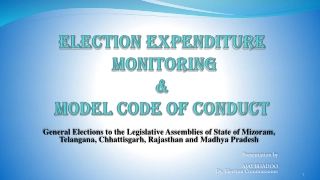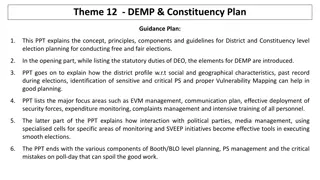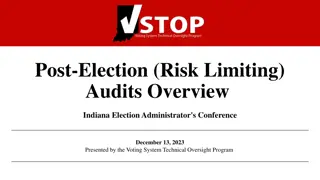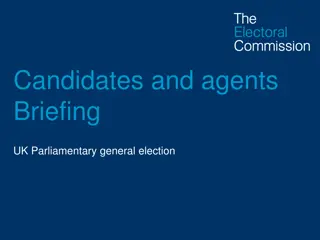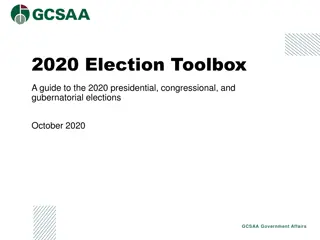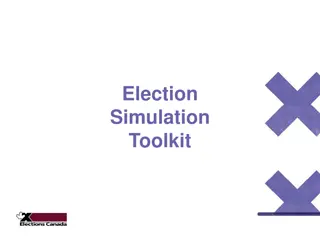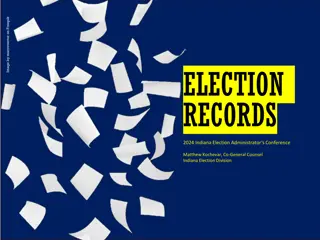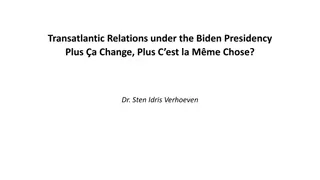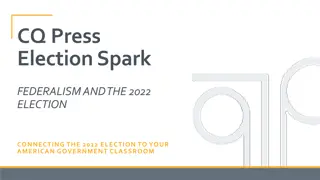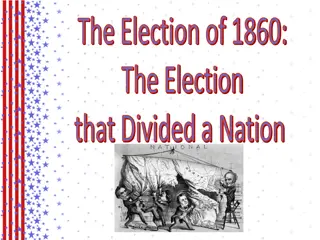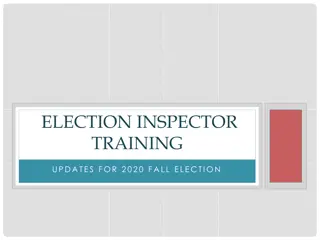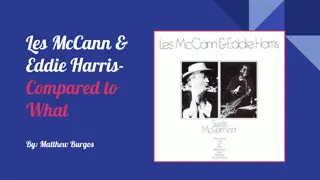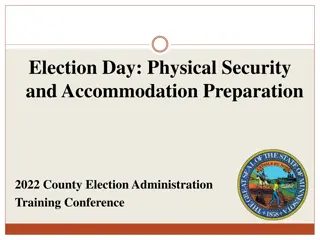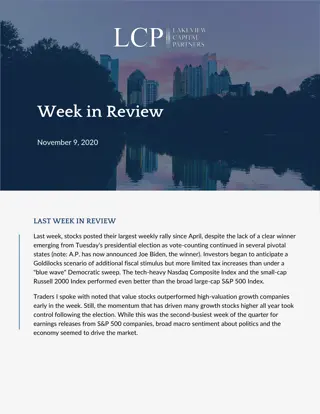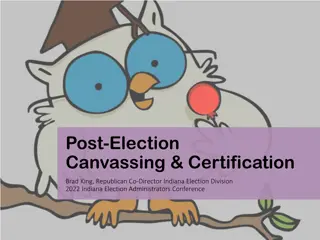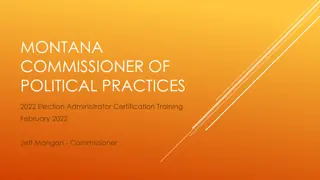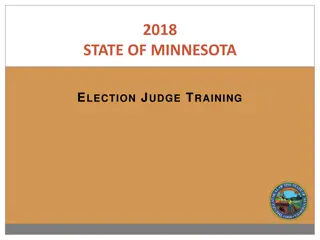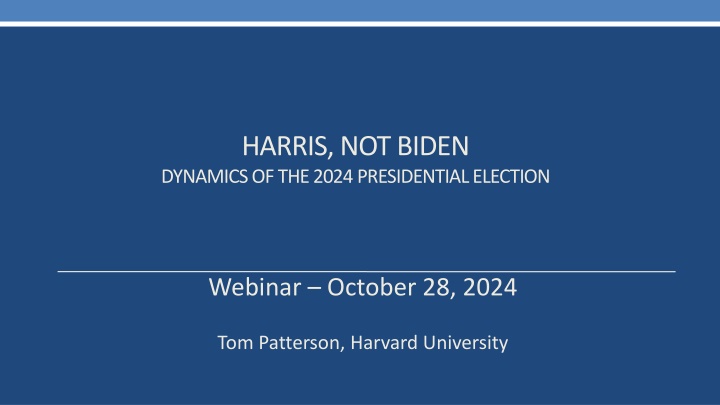
Dynamics of the 2024 Presidential Election: Harris vs. Not Biden
Explore the impact of the switch from Biden to Harris in the 2024 presidential race. Analyze polling data, potential deviations, and the significance of candidate choice on election outcomes. Can poll results be trusted? Delve into the complexities shaping the current political landscape.
Download Presentation

Please find below an Image/Link to download the presentation.
The content on the website is provided AS IS for your information and personal use only. It may not be sold, licensed, or shared on other websites without obtaining consent from the author. If you encounter any issues during the download, it is possible that the publisher has removed the file from their server.
You are allowed to download the files provided on this website for personal or commercial use, subject to the condition that they are used lawfully. All files are the property of their respective owners.
The content on the website is provided AS IS for your information and personal use only. It may not be sold, licensed, or shared on other websites without obtaining consent from the author.
E N D
Presentation Transcript
HARRIS, NOT BIDEN DYNAMICS OF THE 2024 PRESIDENTIAL ELECTION Webinar October 28, 2024 Tom Patterson, Harvard University
We the People, 15e NUMBER ONE the top-selling American Government text Noted for Its Readability a text that students actually like to read To obtain a free instructor s copy of We the People, please email polisci@mhedu cation.com Emphasis on Critical Thinking turning students from passive readers to active ones Balanced there are two sides to American politics Unparalleled Instructor Support Connect, Smartbook, Videos, Podcasts, News Alerts, and more
HARRIS, NOT BIDEN THE DIFFERENCE A CANDIDATE MAKES McGraw-Hill Symposium Tom Patterson, Harvard University
A Campaign With Few Precedents 1. Tightest race in polling history 2. First three-time Republican presidential nominee 3. Highest stakes in memory the country s direction could hinge on the outcome 4. First time a presumptive nominee has quit the campaign in mid-stream Today s Focus: How the switch from Biden to Harris affected the race
Presidential Race, by Month Percentage in favor of . . . Roughly a 3 point swing in Democrats direction Biden drops out on July 21 48.6 47.8 48 46.6 R+1.4 44.9 D+1.4 45.9 41.8 43.7 44.7 41 40.4 39.8 D+1.6 Jun 1st Jul 1st Aug 1st Sep 1st Oct 1st Oct 27th Democrat Republican Source: 538 aggregate of polls
But can the polls be trusted? Here s the record for 2000-2020 4.1 3.3 Overestimated Democratic vote share 1.2 0.9 2000 2004 2008 2012 2016 2020 -2.4 -2.5 Overestimated Republican vote share
Accounting for the 3 percent error in in the 2016 and 2020 polls 2016 undercount of non-college-educated voters 2020 undercount of Trump s most hardcore supporters Pollsters have built those corrections into their models But we won t know if they fixed the problem until votes are cast. The reality? Harris could be slightly ahead nationally (if problem fixed) Trump could be ahead (if the polling problem persists) Harris could have an even bigger lead (if pollsters overcorrected)
A second unknown - Turnout percentage of respondents Already voted 9 Likely to vote 85 Won't vote 3 unsure 2 Source: New York Times/Siena College poll, October 25, 2024
The better turnout predictor Enthusiasm Level Enthusiasm is measured by asking respondents whether they are more enthusiastic than usual in casting their vote. It turns out to be a better predictor of actual turnout than asking people whether they intend to vote.
Enthusiasm Level, 2008-2020 Percentage expressing more enthusiasm than usual about voting in the election In each of these elections, actual turnout was higher for the party that had the higher pre-election enthusiasm Level. 59 2008 D+17 76 70 2012 R+11 59 51 2016 R+2 48 63 D+7 2020 70 Republicans Democrats Source: Gallup polls
Enthusiasm Level 2024 percentage more enthusiastic than usual Republicans 64 D+14 Democrats 78 Source: Galup poll, August 29, 2024
Enthusiasm Level Biden vs. Harris Biden as Democratic nominee (March 2024 poll) Harris as Democratic nominee (August 2024 poll) The Unknown: Gallup hasn t asked this question since August and it s unknown whether Republicans have closed the gap. Percentage "more enthusiastic" than usual percentage "more enthusiastic" than usual Republicans Republicans 59 64 The Known (maybe): Democrats reportedly have the better ground game. : D+14 R+4 Democrats Democrats 55 78 Source: Gallup polls, March and August, 2024
Early Voting (as of Oct 25) percentage of early voters 47 National Although Democrats have the edge nationally and in most states, the margin is smaller than in 2020, when, nationally, they had nearly a 2:1 edge. 32 D+15 35 Arizona 43 R+10 34 N. Carolina Even 34 36 Nevada R+3 39 60 Pennsylvania 30 D+30 Democrats Republicans
The Gender Gap the difference in the voting preference of women and men Democratic percentage of vote of women minus that of men 12 11 10 7 7 2004 2008 2012 2016 2020 Source: Politico, August, 2024
The Gender Gap the difference in the voting preference of men and women Democratic percentage of vote for women minus that for men 14 12 11 10 7 7 If this margin holds, it would be the widest in history of polling 2004 2008 2012 2016 2020 2024 Source: Exit polls, 2004-2020; for 2024, New York Times/Siena College poll, October 25, 2024
Women & Men, 2024 Trump vs. Biden Trump v. Harris Vote preference (percentages) Vote preference (percentages) 53 47 Women Women 41 43 D+12 D+4 39 36 Men Men 53 54 R+14 R+17 Harris Trump Biden Trump Source: New York Times/Sienna College polls, June and October 2024
Black, Hispanic & White Voters Over this period, White voters have dropped from 77% to 66% of the electorate, while Black/Hispanic voters have increased from 19% to 27%. Democratic percentage of two-party vote Black 96 93 71 91 91 70 89 88 67 Hispanic 68 64 55 44 44 42 41 41 40 White, non-Hispanic 2000 2004 2008 2012 2016 2020 Source: Exit polls, 2000-2020 for vote percentages. Census Bureau data for percentage of electorate.
The Black Vote, 2020 and 2024 Vote preference of Black voters (percentages) 91 2020 8 D+83 79 2024 D+68 11 Democratic Republican Sources: Exit polls, 2020: New York Times/Siena College poll, October 25, 2024.
The Hispanic Vote, 2020 and 2024 Vote preference of Hispanic voters (percentages) 67 2020 D+35 32 51 2024 D+9 42 Democratic Republican Source: Exit polls, Newsweek, October 4, 2024.
The White Vote Democrats have not carried the White vote since 1964 and lost by a record margin in 2016 Trump s first presidential campaign. But, there are two white votes that of working-class whites (defined as those without a college degree) and that of college-educated whites.
White Working-Class Voters, 2020 and 2024 Vote preference of White working class voters (percentages) 36 2020 R+26 62 If this margin holds, it would be the widest in history of polling 33 R+30 2024 63 Democratic Republican Source: Exit polls, 2020: New York Times/Sienna College poll, 2024.
White College-Educated Voters, 2012-2020 Voter preference of White college-educated voters (percentages) Democratic presidential nominee 55 54 51 49 46 45 Republican presidential nominee 2012 2016 2020 Source: New York Times, October 2024.
White College-Educated Voters with 2024 added Voter preference of White college-educated voters (percentages) Democratic presidential nominee 55 54 54 51 49 46 45 39 Republican presidential nominee 2012 2016 2020 2024 Source: 2024 data from New York Times/Siena College poll, October 2024.
White College-Educated Voters Trump vs. Biden Trump vs. Harris Vote preference Vote preference If this margin holds, it would be the widest in history of polling Trump 44 Trump 39 D+15 D+7 Biden 51 Harris 54 Source: New York Times/Sienna College polls, June and October 2024
Suburban Voters, 2024 Trump vs. Biden (June 2024) Candidate preference (percentage) Trump vs. Harris (Sept 2024) candidate preference (percentage) 51 D+14 City City 63 36 D+30 33 43 Suburb 52 R+4 Suburb D+10 42 47 rural/town 31 31 Rural/Town 65 R+34 60 R+29 Harris Trump Biden Trump Source: New York Times/Sienna College polls, June and September 2024
Party Identifiers Trump vs. Biden (June 2024) Trump v. Harris (Oct 2024) Vote preference Vote preference 3 Republicans 4 Republicans 88 94 R+3 R+2 85 92 Democrats Democrats 3 4 Biden Trump Harris Trump Source: New York Times/Siena College polls, June & October, 25 2024
Independents A decisive voice when partisans vote the party line Percentage of the independent vote in 2020 Biden 57 Biden s 7 million popular vote margin in 2020 was almost entirely due to his edge among Independents. D+14 Trump 43 Source: Exit polls, 2020
Independents Trump vs. Biden (June 2024) Trump v. Harris (Oct 2024) Vote preference Vote preference Less than two weeks out from the Election, 13 percent are undecided or leaning to a third-party alternative. Trump Trump 34 45 R+3 R+5 Biden Harris 29 42 Source: New York Times/Siena College polls, June & October 25, 2024
Young Voters (ages 18-29) The last time a political party captured the youth vote in a lengthy series of elections was in the Great Depression era. It was the basis for a nearly four- decade period of Democratic Party dominance. percentage of two-party presidential vote 67 62 63 60 55 Democratic nominee 51 49 Republican nominee 45 40 37 33 38 2000 2004 2008 2012 2016 2020 Source: Exit polls, 2000-2020
The cumulative effect of Democratic among young adults, 2020 election percentage of two party-presidential vote in 2020 43 D+14 ages 18-44 57 52 R+4 ages 45 & over 48 Trump Biden Source: 2020 exit polls, based on 2-party vote only
Young voters, 2024 percentage of likely voters, ages 18-29 Trump 42 D+11 Harris 53 Source: New York Times/Sienna College poll, October 25, 2024
2024 Vote Preference by Age percentage of respondents Cumulatively, the young voters who began trending Democratic in 2004 constitute about 40 percent of the electorate. Those who came of voting age in 200 or earlier makeup roughly 60 percent. 49 Ages 18-44 42 45 Ages 45 & older 49 Harris Trump Source: New York Times/Sienna College poll, October 25, 2024
The Battleground States The path to the 270 electoral votes needed to win the presidency
Battleground States When Biden Still in Race Percentage of respondents 42 Wisconsin R+5 37 39 D+2 Pennsylvania 41 45 R+11 N. Carolina 34 39 Michigan R+2 37 42 R+7 Georgia 35 45 R+11 Florida 36 R+6 41 Arizona 35 Trump Biden Source: Based on polls taken in Spring of 2024
Battleground States Now All states are within sampling error Vote preference (percentages) Wisconsin 47.8 47.7 D+.1 Pennslyvania 48 47.6 D+.4 Michigan 47.6 47.2 D+.4 Nevada 47.2 47.5 R+.3 North Carolina R+.5 47.1 48.4 Georgia 48.6 R+1.6 47 Arizona 46.7 48.7 R+2.0 Trump Harris Source: 538. Oct 27, 2024
Can the Battleground Polls Be Trusted? Polling accuracy, 2016 and 2020 Percentage difference between final poll and the actual vote 7 Wisconsin 7 1.7 Pennsylvania 3.6 Except for Nevada 2016 and Georgia in 2020, the polls overestimated the Democratic vote If pollsters haven t Accurately adjusted their Models, Trump may be doing better than polls indicate 2.1 N. Carolina 3.8 1.5 Nevada 2.3 3.3 Michigan 4 0.1 Georgia 0.9 1.5 Arizona 0.6 2020 2016 Source: 538, 2024.
Nebraska? Battleground State? Maine and Nebraska are the only two states that don t use unit rule for electoral votes. The two states award 2 electoral votes to the statewide winner and award one electoral vote per House district to the district winner. This arrangement has made Nebraska s 2nd District a battleground. It s the state s only district where Democrats have a chance of victory.
How Nebraskas 2nd District Could Decide the Election If Harris holds the expected Democratic states, plus Wisconsin, Michigan, and Pennsylvania, she would have 269 electoral votes. A win in Nebraska s 2nd District would then give here exactly the 270 electoral votes needed to win the presidency, In that scenario, if Trump wins the 2nd District, they would be tied at 269 electoral votes. In that case, the election would be decided by the House of Representatives (the one elected in 2024, not 2022) with each state having one vote.
Whos ahead in Nebraskas 2nd District? Vote choice of likely voters (percentages) Trump 42 Harris+9 Harris 51 undecided 7 Source: New York Times/Siena College poll, September 22-24, 2024
Thank you Questions, observations, objections
We the People, 15e To obtain a free instructor s copy of We the People, please email polisci@mheducation.com
The following slides were not presented but may be of interest.
Even if Harris is up by 3 percent, it might not be enough - GOP s electoral college advantage Percentage of two-party presidential vote 54 Democratic nominee 53 53 52 50.2 51 51 51 49 49 49 49.8 48 47 47 46 Democrats have won popular vote in 7 of the last 8 elections but lost 3 of those elections Republican nominee 1992 1996 2000 2004 2008 2012 2016 2020
The House Races number of seats Solid/likely Republican 201 Lean Republican 5 If the solid, likely, and leaning races go as predicted, Republicans will have 206 seats and Democrats 203 seats with control of the House decided by the 25 toss-up races. Toss up 25 Lean Democratic 11 Solid/likely Democratic 192
Generic House Ballot, 2024 If the 2024 House election were held today, would you vote Republican or Democratic? Republican 45 Democratic 47 undecided 8 Source: FiveThirtyEight, October, 2024
2024 Senate Races Of the 34 seats up in 2024 Democrats are defending 23 seats (nearly half of their Senate majority) Republicans are defending 11 seats (less than a fourth of their current members) To gain control of the Senate, Republicans need a net gain of 2 seats or only 1 seat if they win the presidency in 2024.
2024 Senate Races Democrats are defending 23 seats, Republicans 11 seats
The Senate Seats Most Likely to Flip in 2024 Source: Vulnerable seats based on combined assessments of Cook Political Report, 538, and CNN.

